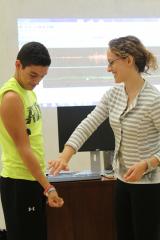
Paola Contessa, technical support specialist and research scientist for Delsys Inc., demonstrates the new wireless electromyography system on Stephen F. Austin State University junior kinesiology major Alvaro Quintanilla as part of the faculty member and student training recently implemented in SFA’s kinesiology and health science department. The wireless EMG system is equipped with sensors that can be placed on muscles to act as antennas measuring the electrical output of the functioning muscles. In her demonstration, Contessa measured the muscle activity of Quintanilla’s biceps as he moved his arm up and down. The department acquired the new equipment and technology to help better educate students, and began to acquire instrumentation that faculty members and graduate students need to conduct musculoskeletal and neuromechanics research and exercise biochemistry research.
Dr. Carla Murgia, chair of the Department of Kinesiology and Health Science, believes this equipment is necessary to support faculty member and graduate student research and undergraduate experiential learning.
“Our faculty members will be able to illustrate theory and provide hands-on experiences for undergraduate students,” Murgia said. “This technology will assist in making theory meaningful to students and help prepare them for careers and post-baccalaureate education. The technology also will provide our faculty members and graduate students with the tools they need to engage in selected research.”
Currently, the department has an array of laboratories that house instrumentation to examine metabolic response to body composition, bone density, and executive and cognitive function in a variety of environments.
“The ability to engage in cutting-edge research will provide faculty members with the ability to advance the existing body of knowledge in the classroom,” Murgia said.
The department has begun to acquire instruments for the new Movement Analysis Lab, which houses four high-speed video cameras, an electromyography system and a decomposition electromyography device, which is located inside SFA’s Lucille Norton Health and Physical Education Complex.
According to Murgia, the clinical and research applications of the lab’s devices are endless. The four high-speed video cameras enable users to create 3-D images and analyze kinematic parameters of the subject’s movement. The cameras detect and record data from the markers that the subjects wear to identify joints and segment endpoints.
“We are able to make the human body into a 3-D image that we can measure angular and linear displacements, velocities, and accelerations,” Murgia said. “We can analyze performance for optimization, movement mechanics that predispose a subject to injury, to measure rehabilitation progress and more.”
The wireless EMG system is equipped with sensors that can be placed on muscles to act as antennas measuring the electrical output of the functioning muscles. This measurement is summative and calculates the total activity of the motor units. The decomposition EMG tool measures the neural impulses for each of the motor units, meaning it looks at the electrical activity of motor units.
Faculty members and students are undergoing training to learn how to use the new technology. In fact, Dr. Jane Grayson, who is the clinical coordinator for the graduate athletic training program, is using the new lab and equipment to assist an SFA graduate student in researching shoulder biomechanics in pitching.
“This equipment teaches students new skills and provides a better understanding of biomechanics and functional anatomy of movement,” Grayson said. “It can potentially attract more graduate students and faculty members into the program.”
A new Biochemistry Exercise Science Lab also has been established in SFA’s Education Annex. Dr. James Rowe, assistant SFA professor, is integrating equipment within this lab that will allow students and professors to test the effects of exercise and nutrition on risk factors associated with diseases that can impact a person’s health.
The biochemistry lab includes equipment that can analyze a person’s blood for markers of heart disease and diabetes such as cholesterol and glucose. In addition, this lab will provide opportunities to learn techniques that can prepare students for careers in the medical field or health research, as well as graduate and post-graduate academic programs.
The department also received FITLIGHT Trainer™ and Fit3D ProScanner technologies. Drs. Mark Faries and Eric Jones, who are the directors for the Human Performance Lab and co-coordinators of the graduate kinesiology program, are using these devices to assess executive and cognitive function aspects of athletic performance.
The FITLIGHT Trainer™ is a wireless training system comprised of LED-powered lights controlled by a tablet, which allows users to alter colors, timing and arrangement to activate and measure cognitive aspects of sports performance such as reaction time, mental processing speed, decision making, problem solving and flexibility of thinking.
According to Faries, the Fit3D Pro Scanner is an innovative machine that captures a full 3-D, 360-degree body scan in seconds. It also provides accurate circumference measurements across the body, which can be used to track body shape changes over time. This machine will help with questions regarding body fat, body shape and health behavior.
“This technology will provide our students hands-on experience to not only understand the physiology of performance or health, but also how the psychology integrates with the physiology,” Faries said. “This integrated mindset for students is crucial for their career preparation.”
The Human Performance Lab also recently acquired a new ParvoMedics Indirect Calorimeter, which performs metabolic analysis in a variety of settings. NASA, the National Institute of Health and the U.S. Olympic training centers also use this equipment.
“Being able to expose students to equipment that is widely used by so many major organizations enhances their experiences, skill set and marketability after graduation,” Jones said.
For more information on the department’s equipment and research, contact Murgia at (936) 468-3503 or murgiac@sfasu.edu.



